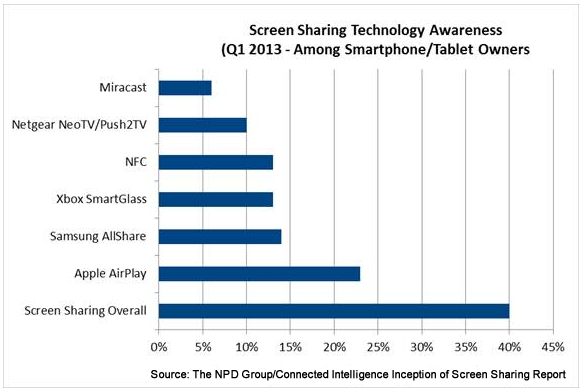This week Verizon and Motorola introduced their new family of Droid phones – the Mini, Ultra, and Maxx. This generation of Droid phones includes the kind of spec upgrades expected in a high-end smartphones. For the most part, all phones in the series have the same hardware such as 2GB of RAM and a 10 mega-pixel camera. Notably different, though, is the 4.3-inch screen in the Mini, the thin form factor of the Ultra (which excludes the wireless charging to reduce the thickness), and the mammoth 3,500 mAh, 48-hour battery in the Maxx. There are plenty of specs and features that give these new phones a “wow factor,” but what we found most interesting is a bit geeky; the manner in which the open source Miracast certified technology is being used to project photos, music, and streaming video from the phone straight to a TV.
To over simply, Miracast is a solution for seamlessly displaying videos, photos, and other media between devices without cables or a network connection. The compatibility of devices is certified through the Wi-Fi Alliance which ensures the technical specifications of a device allow sharing of content to other certified devices. The first Miracast device was certified in September 2012 and according to our Connected Intelligence, Inception of Screen Sharing report, most smartphone and tablet users, 94 percent, are not yet aware of this new technology. At the Verizon launch event Miracast was on display through the new Motorola Droid family of smartphones. Features of a similar screen sharing technology, AllShare, were also presented this year at the Samsung Galaxy S4 launch event. The primary challenges for these technologies are more or less the same, delivering features consumers want in an easy to use manner and generating awareness.
I had the opportunity to speak with Motorola’s Principal Staff Engineer responsible for Miracast integration. Through the brief product demo it appears the new Droid line of smartphones has taken significant steps to nail down the simplicity challenge. Following a one-time set up, using Miracast becomes a one-click process that will rapidly project videos, photos and other media straight to the TV. The process works through the circles widget which is a prominent feature on Droids. It also contains technology that up-scales the picture quality when projecting it and does so with little to no transfer latency. Other technologies have suffered from transfer latency when concurrently streaming video such as Netflix and projecting it to the TV. It appears Motorola has cleared this hurdle.
What remains to be seen is the extent to which this feature will be presented within Droid marketing campaigns and be communicated by sales reps at the point-of purchase. Promotion will be critical, especially considering most of the TVs consumers own today will require the purchase of an adapter to make the technology work. Motorola’s integration and promotion of Miracast technology is one of many steps needed to foster greater awareness for screen sharing. It will take more OEMs to integrate and promote simplified screen sharing applications to drive consumer awareness beyond us tech geeks.
